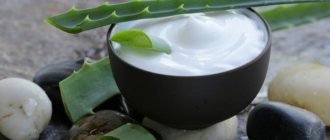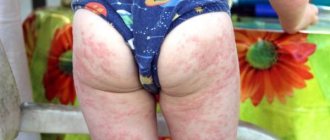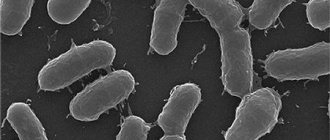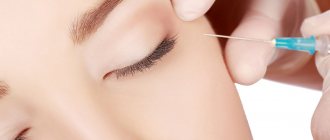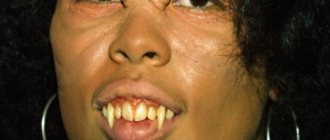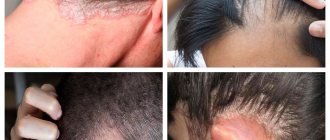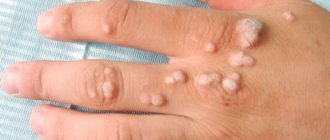Allergies to cosmetics are quite common. Most often, the mucous membranes of the eyes, eyelids, facial skin and décolleté area suffer from an allergic reaction. There are several reasons for allergies to cosmetics. At the same time, the body’s reaction to the use of cosmetics can manifest itself in completely different ways. The most common intolerance to individual components of decorative cosmetics, creams, masks and lotions.
Why allergies occur
Allergy as an essence is an overactive reaction of the body to the effects of allergens
: substances that provoke an undesirable skin reaction. A person is a complex, individual organism, which means that the causes of allergies can be different. Most often, the tendency to certain reactions is due to a whole complex of different factors. These include:
- genetic predisposition;
- hormonal levels, the presence of chronic diseases, vitamin deficiency, decreased immunity during therapy;
- stress, climate change, neglect of protection from UV radiation;
- increased sweating and skin sensitivity.
These factors create an environment for the development of dermatitis -
skin reactions to contact with a certain irritant. In this case, both household chemicals and animals, perfumes, fabrics, flowers, medicines or food can act as an allergen.
Alas, even ordinary nuts can make you sneeze and itch, just like cleansing foam, and even your furry pet. This does not mean that you need to avoid everything around you and live in a hypoallergenic spacesuit. But it’s worth drawing conclusions and becoming more attentive to the world around you and the products you consume.
One of the possible tests for allergies is skin testing. The test is performed by an allergist
Why do eyes suffer from allergies?
The eyes are among the “favorite targets” and areas for the development of allergic reactions. The tissues and structures of the eyeball are thin, very sensitive, not very well protected from the harmful influences of the external environment - and therefore especially vulnerable. The cornea, eyelids, eyelashes, sclera, conjunctiva are in direct contact with the air, where particles of countless substances are contained in suspension, as well as with rain and tap water, with cosmetics, shampoos, creams, eye drops and gels, and contact lenses. In addition, in close proximity and in direct communication with the orbit there are many other equally vulnerable mucous membranes (nose, oral cavity, etc.). The eyes are also susceptible to allergic reactions to substances that enter the body, for example, to individually allergenic foods and medications.
How to recognize allergies to cosmetics
In terms of external manifestations, an allergy to cosmetics may not differ from an allergy to a new coat or perfume. However, there is a difference. Lipstick, cream or mask is applied locally, which means a reaction will occur in this area. You should be alert to symptoms such as:
- local moderate redness at the site of application;
- mild itching and burning;
- dryness, cracks and peeling;
- local tissue swelling.
These symptoms are referred to as simple contact dermatitis.
. The reaction may appear after one application and will disappear as soon as you eliminate the cause of the irritation.
Allergic dermatitis is also distinguished
. It manifests itself in the form of severe itching, rash, bright redness and weeping rashes. It can last a long time and spread to areas of the skin that have not been in contact with cosmetics.
Another type of dermatitis is photoallergic
. It is expressed in the form of rashes on open areas of the skin not protected by clothing, redness and itching. Occurs due to skin sensitivity to the sun (photosensitization) after the use of retinoids, polyunsaturated fatty acids, natural essential oils, para-aminobenzoic (PABA or vitamin B10) and salicylic acids.
Remember: only a doctor can correctly determine the type of irritation, make a diagnosis and select an effective treatment regimen!
First generation drugs
1st generation antihistamines are able to penetrate the nervous system. This helps to quickly eliminate allergy symptoms. However, their effect does not last long, and with long-term use of drugs of this group, addiction may occur. The most common side effects of 1st generation antihistamines are drowsiness, weakness, headache, dizziness and slow reactions. Despite significant disadvantages, these drugs are low in cost and, unlike modern drugs, are available in both tablet and injection form, which allows them to be used for emergency care. Not intended for long-term treatment. In this group there are 4 most effective drugs: diphenhydramine, diazolin, suprastin and tavegil.
- Diphenhydramine. One of the very first antihistamines. Dispensed strictly according to prescription. Used in emergency situations. Not suitable for children.
- Diazolin. Does not cause significant drowsiness. Can be used for prevention purposes. Suitable for use by both children and adults. Longer lasting effect. Ineffective for severe allergic reactions.
- Suprastin. Does not cause significant drowsiness. A rapid therapeutic effect and, compared to other drugs in this group, there are fewer side effects. Has a wider range of indications. Can be used by both adults and children. Not recommended for use in bronchial asthma.
- Tavegil. Used as a treatment for both allergic and pseudoallergic reactions. Does not cause significant drowsiness. Effectively relieves allergy symptoms, especially during the flowering period. Effective for 8 hours (the longest effect from the group of first-generation drugs).
Natural cosmetics = safe cosmetics?
Serum with a high content of vitamin C, tonic with essential oils and lemon, sea buckthorn cream. And no “chemistry”! Sounds tempting. True, this does not mean at all that an allergic reaction will not occur to these extremely “natural”, environmentally friendly products.
This may surprise you, but the most hypoallergenic products are synthetic, since they do not contain proteins that are primarily perceived by the immune system as foreign to the body and requiring immediate destruction. If you pay attention to children's cosmetics from serious large companies, the number one component there will be mineral oil. And not because “they want to destroy children” and “bathe them in oil,” but because this is the safest component that will not cause, for example, Quincke’s edema.
Hypoallergenic cosmetics
People who are familiar with the problem of allergies to cosmetics often buy products from the hypoallergenic group in the future. Do they really protect against allergies?
If a cosmetic product states that it is hypoallergenic, this only means that during testing it was found that this product causes allergic reactions much less frequently than a similar one from the regular series.
However, buyers also need to understand that in most cases there is nothing behind the labels “hypoallergenic”, “natural”, “pure”, “organic” other than a marketing ploy. But not all manufacturers carry out real laboratory tests confirming the hypoallergenicity of products.
Allergens in cosmetics according to European standards
In January 2007, the European Scientific Committee for Consumer Safety (SCCS) approved a special “List 26”. It included 26 substances that most often cause allergies in cosmetics, which, however, can be added to cosmetics, subject to mandatory inclusion on the label. Components from “List 26” are divided into two sections depending on the frequency of allergic reactions.
LIST A
“List A” includes components with a very high frequency of allergic reactions and with a large number of documented evidence.
- Amyl cinnamal is
a synthetic fragrance.
Amylcinnamyl alcohol
is a synthetic fragrance.
Benzyl alcohol
is a component of essential oils of jasmine, hyacinth, and ylang-ylang.
Benzyl salicylate
is a component of many essential oils.
Cinnamyl alcohol
is a component of cinnamon leaf essential oil, as well as Peruvian balsam and styrax.
Cinnamal
is a component of cinnamon bark essential oil.
Citral
is a component of many essential oils with a pronounced lemon sound (from lemon itself to verbena).
Coumarin
is a component of tonka bean essential oil.
Eugenol
is a component of essential oils of bay, cloves, cinnamon, basil, and nutmeg.
Geraniol
is a component of rose, palmarosa, and citronella essential oils.
Hydroxycitronellal
is a synthetic fragrance.
Hydroxymethylpentyl-cyclohexenecarboxaldehyde
is a synthetic fragrance.
Isoeugenol
is a component of ylang-ylang essential oil.
LIST B
“List B” includes components with lower frequency and less documented evidence.
- Anisyl alcohol
is a synthetic fragrance.
Benzyl benzoate is
a component of essential oils of tuberose, hyacinth, as well as Peruvian, Tolu and Copai balsams.
Benzyl cinnamate
is a component of Peruvian, Tolu and Copai balsams.
Citronellol is
a component of rose, geranium, and citronella essential oils.
Farnesol
is a component of many essential oils (from lemongrass to neroli).
Hexyl cinnamaldehyde
is a component of chamomile essential oil.
Lilial is
a synthetic fragrance.
d-Limonene is
one of the main components of citrus essential oils.
Linalool
is a component of many essential oils and is found in 200 types of plants from lavender to cinnamon.
Methyl heptine carbonate
is a synthetic fragrance.
Alpha-Isomethyl Ionone
is a synthetic fragrance.
Oak moss
- oak moss.
Tree moss
is the collective name for mosses.
Causes of allergies to foundation
As a rule, allergic reactions are caused by the presence of some allergen substance. Foundation contains many compounds that can potentially lead to the development of allergies. These are the dyes themselves, preservatives, flavors, and substances that stabilize the formula.
In addition, the reaction to foundation often increases under the influence of seasonal factors, as well as due to too strict diets, decreased immunity and other similar reasons. The fact is that diet destroys the lipid layer that protected the skin from external influences.
It happens that an allergic reaction was caused by expired cosmetics. Foundation should be stored at normal humidity and away from sunlight.
Is it possible to prevent allergies?
A few rules to help you protect yourself:
- Study the ingredients of the products before purchasing.
The most common triggers for rashes and itching are natural fragrances (essential oils), some preservatives, dyes (mainly found in pigments in decorative cosmetics and hair dyes), honey and its derivatives. Rarely: mineral oils, plant extracts, minerals, lanolin. This doesn't mean you should avoid these remedies, but it's best to be on the lookout. Especially with severe skin sensitivity. - Test new cosmetics before use.
To do this, apply a little product to the crook of your elbow and wait up to 48 hours. - Follow the rules for storing products
and do not use cosmetics after the expiration date. - Always follow the manufacturer's recommendations.
Do not overexpose masks, do not apply creams to the mucous membranes, and do not use products intended for professionals without the appropriate skills.
What to do if your skin reacts to cosmetics
If any component of cosmetics does cause an undesirable skin reaction in you, then the first thing to do is stop using this product and wash it off your skin
. After this, you should check the instructions and check the expiration dates. If you did everything correctly and the cosmetics are not expired, act according to the situation:
- Watch the dynamics. If the reaction begins to subside within an hour, it is enough not to use the product anymore.
- Take your usual antihistamine (Suprastin, Fenistil, etc.)
- If symptoms persist, consult your doctor
.
What to do next?
The first desire after purchasing unsuitable cosmetics is to return it to the store and receive compensation from the manufacturer. However, according to the consumer protection law, cosmetics are included in the list of products that cannot be returned or exchanged
(see Decree of the Government of the Russian Federation dated January 19, 1998 No. 55
“On approval of the Rules for the sale of certain types of goods...”
). You can get your money back only in one case: if the cosmetics you bought turned out to be of poor quality. Keep in mind: an individual allergic reaction does not prove that the product is defective.
Therefore, it is better to offer the remedy to someone else, explaining the situation honestly. Place ads on special services, in thematic groups on social networks, or share an unsuitable product with family or friends.
As for further purchases, do not rush to give up shopping! If a rash occurs with one cream, this does not mean that the same reaction will occur with another. Try to establish which component triggered the allergy.
. An allergist can help with this by prescribing the necessary tests. In the future, just avoid products containing this ingredient.
What can cause allergies
It should be noted that an allergic reaction can be caused not only completely, but also by products that a woman has been using for quite a long time. This can be explained as follows.
First, everyone experiences allergy symptoms at different rates. The adverse reaction occurs most quickly in people suffering from seasonal allergies, asthma or eczema.
Secondly, the skin does not necessarily immediately signal an intolerance to a new cosmetic product. This primarily applies to people with strong immune systems. But over time, their immune system loses the ability to resist the inappropriate component in cosmetics and a severe allergic reaction occurs. That is, you can use the same lipstick every day for several months without any unpleasant symptoms, and then suddenly it causes an allergy.
In addition, expired cosmetics can cause an allergic reaction. But a more common cause of allergies is a new cosmetic product. In this case, signs may appear either within a few minutes after using cosmetics, or after several days or even weeks. But most often, allergies to makeup appear after about 24 hours. That is, a reaction to the shadows or primer used in make-up on Saturday evening may very well appear on Monday morning. This often happens the very first time you use a new cosmetic product. The second time, the reaction may occur almost immediately or according to the same principle as the first time.
One clear sign that a cosmetic product is causing an allergy is the fact that the rash or other unwanted symptoms go away after you stop using the product. But even if the allergy has passed and you have probably already understood which product caused it, this is not all that should be done in such a situation. At the next stage, you need to figure out which component in the cream, eye shadow, lipstick or other product caused the undesirable reaction. This knowledge will help you avoid foods that contain the allergen in the future.
Dangerous components in cosmetics
If a certain cosmetic product causes an allergy, the reason should always be sought in its chemical composition. The most common culprits for adverse reactions are metals found in certain types of cosmetics. Typically these are nickel and cobalt. They can be found in many eye shadows, antiperspirants and hair dyes.
The second most common cause of allergies to cosmetics is preservatives, which are added to many products to extend their shelf life. The most powerful allergens from this group are parabens, formaldehydes, and methylisothiazolinone. Preservatives are found in almost everything: from wet wipes to hair products.
Another dangerous ingredient is fragrances added to cosmetics and personal care products. Although additives in this group are generally not harmful to health, they can cause severe reactions in those with sensitive skin.
Also among the potentially dangerous substances for allergy sufferers are propylene glycol, which is used in cosmetics to maintain its moisture, and lanolin, a fat obtained from sheep’s wool.
And one more important point. An allergic reaction can occur not only after contact with synthetic components. The fact that the label of a cosmetic product says that it is natural does not guarantee protection against potential allergies. Many organic ingredients and essential oils are also strong allergens. It should also be remembered that extracts of some plants (especially citrus fruits and St. John's wort) can cause photoallergic reactions.
Or maybe the reason is not cosmetics?
Sometimes symptoms that resemble a makeup allergy may not be caused by cosmetic products at all. This may be a manifestation of increased skin sensitivity, which can appear for various reasons. Most often they are hidden inside the body, or more precisely, in substances obtained from food. Modern food contains many preservatives, pesticides and other components hazardous to health. According to a study by a cosmetics company, increased skin sensitivity can be caused by both internal factors (unhealthy food, parasitosis, helminthic infestations, persistent infections, alcohol and spice abuse, hormonal imbalance) and external factors (wind, sun, poor environment, dust, conditioned air , detergents). But experts call stress the most important enemy of the skin. In a state of chronic stress, the rate of cellular metabolism decreases, which in turn causes the accumulation of toxins in skin cells, giving it jaundice. And constantly high levels of adrenaline increase the risk of eczema.
How we take care of our clients
pays close attention to cosmetic ingredients. We use components from trusted laboratories that have the necessary safety and quality certificates. Before release, our products are tested in laboratories. For your convenience, we place detailed information about the composition and features of the use of our products on the packaging and in product cards in the official online store aravia.ru.
In case of an undesirable skin reaction to the product, we ask you to send us an email
- photos of skin reactions;
- photographs of the product so that the batch number is visible;
- a detailed story about exactly how you used the product;
- additional contacts for prompt communication.
We will then be able to help you and determine the possible cause of the reaction, and decide as quickly as possible how to proceed.
Third generation drugs
If you have an allergy, you should always have antihistamines in your home medicine cabinet.
Officially, third-generation drugs have not yet been developed, however, unofficially, improved second-generation drugs are included in this group. This group is characterized by a rapid onset of action and high efficiency. The drugs have fewer side effects. Individual intolerance is possible. They can be used both to relieve allergy symptoms and for long-term treatment of the disease. They do not affect heart rate. The best third-generation drugs include Cetrin, Erius, Xizal, and Fexofen.
- Cetrin. Available in the form of tablets (contraindicated in children under 6 years of age) and in the form of syrup (contraindicated in children under 2 years of age). The effect lasts up to 24 hours. Effective in the development of edema. Syrup as part of complex therapy relieves spasms in bronchial asthma. It has virtually no contraindications. Should be used with caution in elderly people.
- Erius. Available in the form of tablets (contraindicated in children under 12 years of age) and syrup (contraindicated in children under 1 year of age). It works almost immediately. Duration of action is up to 24 hours. Relieves and prevents the development of allergy symptoms. Should be taken with caution in case of renal failure
- Xizal (Zodak). Available in the form of tablets and drops. Has an anti-inflammatory effect. Quickly eliminates itching, swelling and redness. The effect of the drug is observed for up to 2 days. Contraindicated in renal failure. Not suitable for use by children under 6 years of age.
- Fexofen (Allegra, Fexofast). Effectively eliminates allergy symptoms, especially with seasonal rhinitis. The effect lasts for 12 hours. Can be used as prophylaxis. Not suitable for use by children under 12 years of age.
